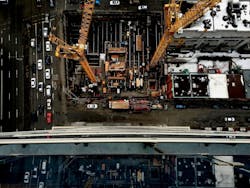DOE funds 18 projects developing tech to enable buildings to store carbon
By Peter Fabris, Contributing Editor
The Department of Energy announced $39 million in awards for 18 projects that are developing technologies to transform buildings into net carbon storage structures.
Several of the awards are targeted for alternative concrete and cement materials as part of DOE’s drive to improve energy efficiency and reduce greenhouse gas emissions in the built environment. “There’s huge, untapped potential in reimagining building materials and construction techniques as carbon sinks,” Jennifer M. Granholm, DOE secretary, said in a press release.
Other projects funded by the DOE include:
- Development of “living” wood with the strength of steel, a self-healing capability, and combined carbon-sequestering benefits from wood and microbes by Purdue University.
- Development of a composite panel containing bio-derived natural fibers that exhibit excellent mechanical and functional properties while maintaining a carbon-negative footprint by SkyNano LLC.
- Design of a carbon-negative, medium-size building structure using a high-performance floor system with maximized surface area for carbon absorption that uses a novel carbon absorbing concrete mixture as a building material at the University of Pennsylvania.
The DOE awards are intended to help meet the goal of net zero emissions by 2050 outlined in an executive order signed by President Biden last year to make the federal government carbon neutral. The program aims for a 65% reduction in greenhouse gas emissions by 2030.
